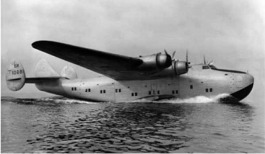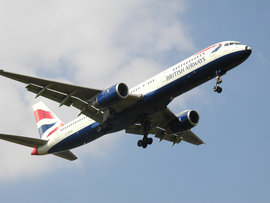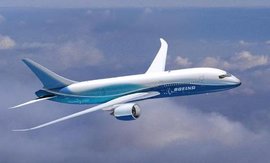Boeing
|
|
Template:Infobox Company The Boeing Company Template:Nyse is a leading American aircraft and aerospace manufacturer, headquartered in Chicago, Illinois, with its largest production facilities in Everett, Washington, near Seattle, Washington. It is also a defense contractor, and a component of the Dow Jones Industrial Average.
Boeing's two principal divisions are Boeing Integrated Defense Systems (IDS), responsible for military and space products, and Boeing Commercial Airplanes (BCA), responsible for civil airliners. (For a full list of subsidiaries, see below.)
| Contents |
History
Before 1950s
The company was founded in Seattle by William E. Boeing on July 15, 1916, together with George Conrad Westervelt, a U.S. Navy engineer, and was named "B&W" after their initials. Soon the name was changed to "Pacific Aero Products" and, in 1917, the company became the "Boeing Airplane Company." William E. Boeing had studied at Yale University and worked initially in the timber industry, where he became a rich man. There he also acquired knowledge about wooden structures which was later revealed to be of value for the design and assembly of airplanes.
In 1927, Boeing created an airline, named Boeing Air Transport (BAT). A year later, BAT, as well as Pacific Air Transport and Boeing Airplane Company merge into a single corporation. The company changed its name to United Aircraft - Transport Corp. in 1929 and acquired Pratt & Whitney, Hamilton Standard Propeller Company, and Chance Vought. United Aircraft then purchased National Air Transport in 1930. The Air Mail Act of 1934 prohibited airlines and manufacturers from being under the same corporate umbrella, so the company split into three smaller companies - Boeing Airplane Company, United Airlines, and United Aircraft Corporation, the precursor to United Technologies. Bill Boeing sold his shares, as a result.
Shortly after, an agreement with Pan American World Airways was reached, to develop and build a commercial flying-boat able to carry passengers on transoceanic routes. The first flight of the Boeing 314 Clipper was in June 1938. It was the largest civil aircraft of its time, with a capacity of 90 passengers on day flights, and of 40 passengers on night flights. One year later, the first regular passenger service from the US to the UK was inaugurated. Subsequently other routes were opened, so that soon Pan American flew with the Boeing 314 to destinations all over the world.
In 1938, Boeing completed work on the Model 307 Stratoliner. This was the world's first pressurized-cabin transport aircraft, and it was capable of cruising at an altitude of 20,000 feet. — above most weather disturbances.
During World War II, Boeing built a huge number of bombers. Many of the workers were women whose spouses had gone to war. In the beginning of March 1944, production had been scaled up in such a manner that over 350 planes were built each month. To prevent an attack from the air, the plants had been covered with greenery and farmland items. During these years of war the leading aircraft companies of the US cooperated. The Boeing-designed B-17 bomber was assembled also by Lockheed Aircraft Corp. and Douglas Aircraft Co., while the B-29 was assembled also by Bell Aircraft Co. and by Glenn L. Martin Co.
After the war, most orders of bombers were canceled and 70,000 people lost their jobs at Boeing. The company aimed to recover quickly by selling its Stratocruiser, a luxurious four-engine commercial airliner developed from a military aircraft. However, sales of this model were not as expected and Boeing had to seek other opportunities to overcome the situation. The company sold with success military aircraft adapted for troop transportation and for aerial refueling.
1950s
In the mid-1950s technology had advanced very significantly, which gave Boeing the possibility to develop and manufacture totally new products. One of the first was the guided short-range missile used to intercept enemy aircraft. At that time the Cold War had become a fact to live with, and Boeing used its short-range missile technology to develop and build also an intercontinental missile.
In 1958, Boeing began delivery of its B707, the United States' first commercial jet airliner, in response to the British De Havilland Comet and the French Sud Caravelle, the world's first commercial jet aircraft. With the B707, a four-engine, 156-passenger airliner, the US became leaders in commercial jet manufacture. A few years later, Boeing added a second version of this aircraft, the B720. A few years later, Boeing introduced the B727, another commercial jet airliner of similar size, which had however three engines and was designed for medium-range routes. The B727 was immediately well accepted as a comfortable and reliable aircraft by passengers, crews, and airlines. Although production was discontinued in 1984, at the turn of the millennium nearly 1,300 B727s were still in service at airlines around the world.
1960s
The Piasecki Helicopter company was acquired by Boeing in 1960, and this became Boeing Vertol. The twin-rotor CH-47 Chinook, produced by Vertol, took its first flight in 1961. This heavy-lift helicopter remains a work-horse vehicle up to the present day. In 1964, Vertol also began production of the CH-46 Sea Knight.
UA747.HNL.1973..reprocessed.arp.jpg
In 1967, Boeing introduced another short- and medium-range airliner, the twin-engine B737. It has become since then the best-selling commercial jet aircraft in aviation history. The B737 is still being produced, and continuous improvements are made. Several versions have been developed, mainly to increase seating capacity and range.
The roll-out ceremonies for the first 747-100 took place in 1968, at the massive new factory in Everett. The aircraft made its first flight a year later, and its first commercial flight occurs in 1970.
1970s
In the beginning of the 1970s Boeing faced a new crisis. The Apollo program in which Boeing had participated significantly during the preceding decade was almost entirely cancelled. Once more, Boeing hoped to compensate sales with its commercial airliners. At that time, however, there was a heavy recession in the airlines industry so that Boeing did not receive one single order during more than one year. Boeing's bet for the future, the new B747 Jumbo Jet was delayed in production and originated much higher costs than forecasted. Another problem was that, in 1971, the U.S. Congress decided to stop the financial support for the development of the supersonic 2707, Boeing's answer to the British-French Concorde, forcing the company to discontinue the project. The company had to reduce the number of employees from over 80,000 to almost half, only in the Seattle area. In 1970 the first B747, a four-engine long-range airliner, finally entered service. This famous aircraft changed completely the way of flying, with its 450-passenger seating capacity and its upper deck. Until 2001, Boeing had been the only aircraft manufacturer to offer such an airliner and has delivered near to 1,400 units. (Airbus now offers the A380, which when delivered will be the largest operational airliner). The B747 has undergone continuous improvements to keep it technologically up-to-date. Larger versions have also been developed by stretching the upper deck.
1980s
In 1983, the economic situation began to improve. Boeing assembled its 1,000th B737 passenger airliner. During the following years, commercial aircraft and their military versions became the basic equipment of airlines and air forces. As passenger air traffic increased, competition was harder, mainly from a European newcomer in commercial airliner manufacturing, Airbus. Boeing had to offer new aircraft, and developed the single-aisle B757, the larger, twin-aisle B767, and upgraded versions of the B737. An important project of these years was the Space Shuttle, to which Boeing contributed with its experience in space rockets acquired during the Apollo era, in which the company also participated. Boeing participated also with other products in the space program, and was the first contractor for the International Space Station. At the same time, several military projects went into production, like the RAH-66 Comanche helicopter, the Avenger air defense system and a new generation of short-range missiles. During these years, Boeing was very active upgrading existing military equipment and developing new ones.
Boeing777.jpg
1990s
In 1994, Boeing introduced its most modern commercial jet aircraft, the twin-engine B777, with a seating capacity of 390 passengers, in between the B767 and the B747. Despite having only two engines, the B777 is certified to fly routes over oceans and deserted zones (see ETOPS), and is being sold very successfully. This aircraft, affectionately known as the "triple seven," reached an important milestone by being the first airliner to be designed "entirely by computer," i.e. by using CAD techniques. Also in the mid-1990s, the company developed the revamped version of the B737, known as the "Next-Generation 737." It has since become the fastest-selling version of the B737 in history. The "Next-Generation 737" includes the 737-600, the 737-700, the 737-800, and the 737-900.
In 1996, Boeing merged with Rockwell International Corp.’s aerospace and defense units. The Rockwell products became a subsidiary of Boeing, named Boeing North American, Inc. One year later, Boeing merged with McDonnell Douglas Corp. Following the merger between Boeing and McDonnell Douglas, the McDonnell Douglas MD-95 was renamed the Boeing 717. and the production of the MD-11 was stopped.
2000s
In recent years Boeing has faced an increasingly competitive Airbus, which offers commonality between models and the latest fly-by-wire technology. From the 1970s Airbus has increased its family of aircraft to the point where they can now offer an aircraft in every class Boeing does. Indeed Airbus is now competing in markets that Boeing once had a monopoly over, e.g. the A320 has been selected by two low-cost operators (the aircraft used by these airlines has traditionally been the 737) and the very large aircraft market, the A380 has won every major order over the 747 since its launch. The 747 is also being cannibalized by healthy sales of Boeing's own competitor, the 777-300 Series.
Currently, Boeing is planning to introduce two new aircraft, the 787 "Dreamliner", and the ultra-long-range 777-200LR. The Boeing 787 was formerly known as the Boeing 7E7, but the designation has since been changed. The Boeing 777-200LR will have the longest range of any commercial aircraft, and will be the first airliner to able to fly halfway across the planet with a commercially viable payload. The 777-200LR has already entered flight-testing, with the first aircraft due to be delivered to Pakistan International Airlines in 2006.
In 2004, Boeing canceled production of the 757 after more a thousand were produced, with the last few aircraft went to airlines in China, as advanced versions of the 737 were beginning to compete against the older design. Boeing also soon canceled the production of 717 due to slow sales, and the 767 is likely to cease production soon. However, if Boeing manages to win the contract for new USAF tankers, the 767 program might be saved. Boeing also plans to a '747 Advanced' that will compete more closely with the Airbus A380. The aircraft was informally announced at the 2005 Paris Airshow.
Recent History
After several decades of numerous successes, Boeing lost ground to Europe's Airbus and subsequently lost its leadership of the market in 2003. It responded by running a huge advertising campaign to promote its new motto, "Forever New Frontiers," and rehabilitate its image. Hopes are now focused on the newly-launched 787 as a platform of total fleet rejuvenation.
On October 10 2001, against fierce competition for the contract to the JSF, Boeing lost to rival Lockheed Martin in the multi-billion dollar contract. Boeing's competitor was the X-32, which lost out to Lockheed's F-35 entrant. The X-32 may have been hampered by the requirement for a redesign after several flaws were found in the original concept.
"Unethical conduct"
In May 2003 the US Air Force announced it would lease 100 KC-767 tankers to replace the oldest 136 of its KC-135s. The 10 year lease would give the USAF the option to purchase the aircraft at the end of the contract. In September 2003, responding to critics who argued that the lease was vastly more expensive than an outright purchase, the DOD announced a revised lease of 74 aircraft and purchase of 26.
In December 2003 the Pentagon announced the project was to be frozen while allegations of corruption by one if its former procurement staffers, Darleen Druyun (who had moved to Boeing in January) was investigated. The fallout of this resulted in the resignation of Boeing CEO Philip M. Condit and the termination CFO Michael M. Sears. Harry Stonecipher, former McDonnell Douglas CEO, replaced Condit.
Druyun pleaded guilty to inflating the price of the contract to favor her future employer and to passing information on the competing Airbus A330 MRTT bid (from EADS). In October 2004 she was sentenced to nine months in jail for corruption, fined $5,000, given three years of supervised release and 150 hours of community service.
In March 2005 the Boeing board forced President and Chief Executive Officer Harry Stonecipher to resign. Boeing said an internal investigation revealed a "consensual" relationship between Stonecipher and a female executive that “violated the company's Code of Conduct” and "would impair his ability to lead the company."
Industrial espionage
In June 2003 Lockheed Martin sued Boeing alleging the company had resorted to industrial espionage in 1998 to win the Evolved Expendable Launch Vehicle (EELV) competition. Lockheed alleged that a former employee; Kenneth Branch, who went to work for McDonnell Douglas and Boeing, passed 25,000 proprietary documents to his new employers. Lockheed argued that these documents allowed Boeing to win 21 of the 28 tendered military satellite launches.
In July 2003 Boeing was penalized, with the Pentagon stripping $1 billion worth of contracts away from the company and awarding them to Lockheed. Furthermore, the company was forbidden to bid for rocket contracts for a 20 month period which expired in March 2005.
Airbus subsidy dispute
In October 2004, Boeing filed a complaint at the World Trade Organization, claiming that Airbus had violated a 1992 bilateral accord when it received what Boeing deems as "unfair" subsidies from the European Union. Airbus retaliated by filing another complaint, contesting that Boeing had also violated the accord when it received tax breaks from the U.S. Government. Moreover, the E.U. also complain that the investment subsidies from Japanese airliners violate the accord.
In January 11, the two parties (Boeing and Airbus) agreed that they would attempt to find a solution to the dispute outside of the WTO.
However, in June 2005, Boeing and the United States government reopened the trade dispute with the WTO, claiming that Airbus had received illegal subsidies from the EU government. Airbus has also retaliated against Boeing, reopening the dispute and also accusing Boeing of receiving subsidies from the US government.
Product developments
Finally, Boeing achieved several consecutive successes, beginning with the formal launch of the 787 for delivery to All Nippon Airways and Air New Zealand. Currently, the 787 orderbook stands at over 250 airframes with orders from Continental Airlines, Japan Airlines, Icelandair and a conglomeration of Chinese carriers.
Boeing also received the launch contract from the US Navy for the Multimission Maritime Aircraft, an anti-submarine warfare patrol aircraft. Several orders for the Wedgetail AEW&C aircraft are expected as well.
In November 2004, Boeing announced it will offer a cargo version of the popular 777 model. The freighter will be based on the 777-200LR. Customers rumored to be interested include Lufthansa, EVA Airways, and Emirates.
Divisions
The two largest divisions are Boeing Commercial Airplanes and the Integrated Defense Systems group.
- AviationPartnersBoeing, a 50/50 joint venture with Aviation Partners, Inc.
- Boeing Australia, Ltd.
- Boeing Capital
- Boeing Commercial Airplanes
- Aeroinfo Systems
- Airspace Safety Analysis Corporation
- Alteon Training, formerly FlightSafetyBoeing
- Continental Datagraphics
- Jeppesen Sanderson
- SBS International
- Boeing Integrated Defense Systems
- Phantom Works
- Rocketdyne, being sold to Pratt & Whitney
- Boeing Satellite Systems
- Sea Launch (40%)
- Boeing Realty
- Boeing Shared Services Group
- Boeing Travel Management Company
- Boeing Connexion
- Preston Aviation Solutions
Miscellaneous
The Boeing company culture has long had a tradition of strong community support. The Boeing employee community fund is the largest employee-owned and managed fund in the world.
See also
External links
- The Boeing Company (http://www.boeing.com/)
- Boeing order sheet, year-to-date (http://www.boeing.com/commercial/orders/)
- Yahoo! - The Boeing Company Company Profile (http://biz.yahoo.com/ic/10/10221.html)
- Boeing and WTO (http://www.buffalo.edu/reporter/vol35/vol35n40/articles/Boeing.html)
- Aircraft-Info.net - Boeing (http://www.aircraft-info.net/aircraft/jet_aircraft/boeing/)
- BBC (http://news.bbc.co.uk/2/hi/business/3722888.stm)
|
Lists of Aircraft | Aircraft manufacturers | Aircraft engines | Aircraft engine manufacturers Airports | Airlines | Air forces | Aircraft weapons | Missiles | Timeline of aviation |
bg:Boeing da:Boeing de:Boeing es:Boeing fr:Boeing id:Boeing nl:Boeing ja:ボーイング no:Boeing pl:Boeing Company pt:Boeing fi:Boeing sv:Boeing th:โบอิง zh:波音




